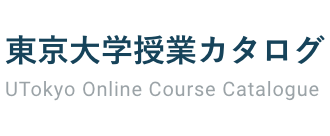学内のオンライン授業の情報漏洩防止のため,URLやアカウント、教室の記載は削除しております。
最終更新日:2025年4月21日
授業計画や教室は変更となる可能性があるため、必ずUTASで最新の情報を確認して下さい。
UTASにアクセスできない方は、担当教員または部局教務へお問い合わせ下さい。
最終更新日:2025年4月21日
授業計画や教室は変更となる可能性があるため、必ずUTASで最新の情報を確認して下さい。
UTASにアクセスできない方は、担当教員または部局教務へお問い合わせ下さい。
Law and Public Policy
How does law realize public policy? What prevents laws to be effective? How can practitioners prepare for various stages in the making of law and public policy? With the focus on international economic law, this course will address these questions by exploring the two-level game theory, which views international negotiations as simultaneous discussions at both the domestic and international levels, as well as the concept of ambiguity of law. This course is structured around three learning objectives: (1) understanding the theories of law and public policy; (2) applying theoretical understanding of law and public policy to real-life issues and cases; and (3) experiencing negotiations and briefings which are the daily activities of practitioners.
時間割/共通科目コード
コース名
教員
学期
時限
5111190
GPP-MP5L10L3
Law and Public Policy
塩尻 康太郎
木曜6限
Ethics and International Relations
By the end of this course the students should have acquainted themselves with the main questions lying at the intersection of ethics and International Relations/international politics, becoming familiar with the concepts and jargons of ethical theory, just war, ethics of war and warfare, responsibility to protect, human rights and global justice.
時間割/共通科目コード
コース名
教員
学期
時限
5122137
GPP-MP6P20L3
Ethics and International Relations
ORSI Roberto
木曜4限
International Environmental Law
International environmental law (IEL), an evolving branch of international law aimed at protecting the environment, has provided a legal framework for addressing transboundary environmental challenges. The objectives of the course is to deepen understanding of historical developments, basic concepts and principles, feature of IEL in a comprehensive manner, and to examine various contemporary and cross-cutting issues, such as climate change, trade and the environment, and human rights and the environment, with view to exploring a possible solution in a practical and creative manner.
時間割/共通科目コード
コース名
教員
学期
時限
5121121
GPP-MP6L20L3
International Environmental Law
高村 ゆかり
水曜5限
環境影響評価制度論
Environmental Impact Assessment, EIA is one of the most essential environmental policy tool for achieving "Sustainable Development, SD", "SDGs" and "Nature Positive (No Net Loss)". However EIA system is not known in our societies. The goal of this course is to understand what EIA system is and how EIA can apply to avoid environmental problems resulting from development projects. Because development projects are main couses of environmental problems among human activities.
You will learn fundamentals of EIA including purpose, procedure, methodology with understanding relationship between "Sustainable Development, SD", "SDGs", "Nature Positive (No Net Loss)" and EIA.
This course focuses on, "mitigation" process in EIA procedure. Because if “impacts” steming from development projects can be defined environmental “problems” in EIAs, "mitigation" corresponds to “solution” against those problems. This course also focuses on natural environment/biological issues such as ecosystems, habitats, endangered species, flora & fauna, secondary natural ecosystems such as "Satoyama". Because healthy natural ecosystems are keys of sustainability and fundamentals of human societies. For this reason, you will learn threatening Japan's nature, "Satoyama", a secondary natural ecosystem as well.
As an ecological impact assessment tool, Habitat Evaluation Procedure (HEP) and Habitat Suitability Index Models (HSI models), the most popular quantitative habitat assessment methods are also learned. “Biodiversity offset” and its market-oriented economic instrument “biodiversity banking” are discussed as the forefront of strategic ecological mitigation measures. We may also discuss relationship between newly introduced policies/mechanisms such as "Nature Positive", "TNFD, "30 by 30".
時間割/共通科目コード
コース名
教員
学期
時限
08D1403
FAS-DA4F03L3
環境影響評価制度論
田中 章
金曜3限、金曜4限
Science, Technology and Public Policy
This course will deal with wide range of issues from local to global levels faced at the interface areas between science, technology and public policy from comparative perspective of Japan, the US and Europe. It offers key theoretical issues surrounding Science and Technology and provides students with the tools and frameworks, such as risk assessment/ management and transition management, to analyze them. This course invites students from both natural science backgrounds (i.e. the graduate school of engineering, new frontier science and so on) and social science backgrounds (graduate school of public policy, law and politics, and economics and public policy). We expect students to acquire interdisciplinary perspective in addition to their primary major, which is one of the critical skill in analyzing complex social technical issues posed by science and technology.
時間割/共通科目コード
コース名
教員
学期
時限
3792-146
GEN-TM6n49L3
Science, Technology and Public Policy
松尾 真紀子
月曜3限、水曜4限
Competition Law and Policy
・競争法の思考方法を、まずは比較法に基づく広い視野から英語で、次に日本の独禁法に絞って日本語で、体系的に修得することを目的とする。
This course aims to give you a solid understanding of how competition law works. We start with a broad, comparative perspective in English, then move on to Japanese competition law in Japanese.
競争法は、市場において企業がどこまでの行為が許されるのか、その境界線を設定する。試合におけるレフェリーのようなものである。日本では独占禁止法としても知られている。
Competition law sets the boundaries of what companies are allowed to do in the marketplace. It is like the referee in a boxing match. In Japan, the rules of competition law are mostly found in the Antimonopoly Act.
この講義は二つのパートで構成されている。
第1部(英語):競争法の主要な概念および基本原則
第2部(日本語):日本の独占禁止法の事例を用いた体系的講義
This course consists of two parts:
- Part 1 (in English): key concepts and fundamental principles in competition law
- Part 2 (in Japanese): a systematic overview of Japanese competition law, including case law
第1部は Vande Walle教授が英語で担当し、第2部は 滝澤教授が日本語で担当する。第1部では、学生は英語で短いレポートを提出する必要がある。第2部は、学期末に行われる日本語の筆記試験で評価される。
Part 1 will be taught in English by Professor Vande Walle. Part 2 will be taught in Japanese by Professor Takizawa. For part 1, students will be required to write a short paper in English. Part 2 will be tested by a written exam at the end of the semester in Japanese.
時間割/共通科目コード
コース名
教員
学期
時限
5121020
GPP-MP6L20L1
Competition Law and Policy
VANDE WALLE Simon
水曜3限、金曜2限
Introduction to International Politics
At the end of this course, the student should have familiarised with a series of ongoing discussions concerning the nature of international politics, both in its theoretical articulation and in its several sectorial dimensions. International political theory will be introduced through an analysis of the ma-jor schools of thoughts providing a definition of what international politics is about (ontology) and how it is supposed to be studied (epistemology). The students will become familiar with the concepts of realism, Realpolitik, anarchy, power, national interest, zero-sum-game, relative vs. absolute gain, polarity, globalisation, sphere of influence, intervention, human rights, emancipation.
時間割/共通科目コード
コース名
教員
学期
時限
5112260
GPP-MP5P10L3
Introduction to International Politics
ORSI Roberto
水曜5限
Strategic Communications and International Politics
Strategic communications occupy a particularly significant place in world politics today. This course provides the background for understanding the expanded role of communications in contemporary international security and provides a theoretical framework for analyzing/explaining the role of strategic communications in contemporary diplomacy and statecraft. This course will further situate contemporary uses of strategic communications in the evolving character of threats today, especially the hybridization of threats and conflicts. Issues covered include: functions and approaches of strategic communications; the social impact of the evolution of information technologies; public affairs and public diplomacy; military psychological operations and information operations; history of disinformation, and evolution in Foreign Information Manipulation and Interference (FIMI); networks and hierarchies; governmental institutions and the apparatus of strategic communications; and strategic communications in the Indo-Pacific.
It is a preparatory course for Capstone Course: Strategic Communications: From Concepts to Applications; and the GraSPP-King’s College London double-degree programme.
時間割/共通科目コード
コース名
教員
学期
時限
5122219
GPP-MP6P20L3
Strategic Communications and International Politics
青井 千由紀
水曜6限
Governance and Development
The objectives of the course are: 1) to give students a historical understanding of the context of the rise and fall of major development theories on which donors have based their aid policies; 2) to deal with the ways in which current international development cooperation takes place in the areas at issue - with the primary focus being placed on ‘governance’ amongst them; 3) to provide a critical assessment of the ways in which the concept of ‘governance’ is framed through international development discourse in general and development aid in particular.
By the end of the course, students will be able to understand firstly why a certain theory was emerged at a certain point of history and why it was adopted by donors, and how it was turned into their aid policies. Secondly, students will deepen their understandings of the impact of implemented aid policies on recipient states’ governments and societies at large - i.e. the governance of recipient states. Thirdly, students will be able to follow up emergent ‘unorthodoxies' that challenge the dominant discourse on governance and development in the international aid industry.
時間割/共通科目コード
コース名
教員
学期
時限
5112220
GPP-MP5P10L3
Governance and Development
元田 結花
水曜6限
Governance and Policies of EU
European Union has a unique system of governance. On the one hand, it has a feature of international organization as a collection of sovereign state, but on the other, it has autonomous authority and competence to govern. This course will provide how EU came to this form of governance and what are the policies that has been conducted within EU. It will discuss the issues in recent years such as Brexit, emergence of populist movements, and migration issues.
時間割/共通科目コード
コース名
教員
学期
時限
5122061
GPP-MP6P20L1
Governance and Policies of EU
鈴木 一人
月曜5限
1-10 / 全9578件









 マイリストに追加
マイリストに追加
 マイリストから削除
マイリストから削除


